Assessing the Impacts of Climate and Land Use Change on Water Conservation in the Three-River Headstreams Region of China Based on the Integration of the InVEST Model and Machine Learning
Abstract
:1. Introduction
2. Materials and Methods
2.1. Study Area
2.2. Data Sources and Processing Methods
2.3. Dataset Generation via ArcGIS
2.4. Methods
2.4.1. The InVEST Water Yield Model and Water Conservation Computation
2.4.2. Trend Analysis
2.4.3. Correlation and Cluster Analysis
2.4.4. Machine Learning Model
3. Results
3.1. Water Conservation Simulation Results
3.1.1. The Validation Process for the InVEST Model
3.1.2. Simulated Results of Water Yield and Water Conservation
3.2. Trend Analysis of Water Conservation and Natural Factors
3.2.1. Trend Variation of Water Conservation and Natural Factors
3.2.2. Fluctuations in Water Conservation across Various Land Use Types
3.2.3. Mutations in Water Conservation and Natural Factors
3.3. Correlation Analysis between Driving Factors and Water Conservation
3.4. Random Forest to Assess the Importance of Each Driving Factor on Water Conservation
4. Discussion
4.1. Variability in Water Conservation across Different Source Regions
4.2. Analysis of the Abrupt Changes in Water Conservation
4.3. Comprehensive Analysis of the Factors Affecting Water Conservation
5. Conclusions
- (1)
- The InVEST model was employed, and an average WC of 50.36 mm was computed for the TRHR during the period 1980–2018, with a total WC amounting to 189.33 billion m3, exhibiting a nonsignificant increasing trend. However, discernable disparities in WC alterations were observed among different basins. The LRB, with the highest WC, exhibited a declining fluctuation, possibly due to rapid vegetation augmentation and inconspicuous precipitation increments in this zone. Due to higher precipitation, lower potential evapotranspiration, and elevated vegetation cover, the YRB displayed the most pronounced WC augmentation.
- (2)
- Between 1980 and 2018, temporal junctures of abrupt environmental factor changes and abrupt WC changes were closely aligned, especially in approximately 2000, when WC transitioned from gradual diminution to noticeable augmentation. Moreover, post-2000, despite the positive transition in land use patterns, its favorable impact on WC progressively attenuated.
- (3)
- Precipitation emerged as the predominant driver for WC enlargement, while FRACTP and ET0 impeded WC enlargement. Grasslands made the most significant contribution to WC in the TRHR, accounting for approximately 84.90% to 87.78%.
Author Contributions
Funding
Data Availability Statement
Conflicts of Interest
Appendix A. Methods
Appendix A.1. The InVEST Water Yield Model and Calculation of Water Conservation
Appendix A.2. M-K Mutation Detection Methods
Appendix A.3. Land Use Transfer Matrix
| No. | Land Use Type | Description |
|---|---|---|
| 1 | Cropland (CL) | Refers to paddy fields as no dry lands were found in the study area. |
| 2 | Forest Land (FL) | Encompasses forested areas, shrublands, sparse forests, and other forms of woodland. |
| 3 | High-Coverage Grassland (HCG) | Denotes natural grasslands, mowed grasslands, and improved grasslands with vegetation cover exceeding 50%. |
| 4 | Medium-Coverage Grassland (MCG) | Refers to natural and improved grasslands with vegetation cover ranging from 20% to 50%. |
| 5 | Low-Coverage Grassland (LCG) | Refers to natural grasslands with vegetation cover ranging from 5% to 20%. |
| 6 | Water Bodies (WB) | Refers to natural terrestrial waters and hydraulic facilities, mainly including rivers, lakes, beaches, reservoirs, and permanent glaciers and snowfields. |
| 7 | Built-up Land (BL) | Refers to land used for urban and rural residential areas, as well as other built-up areas such as industrial parks and transportation facilities. |
| 8 | Unused Land (UL) | Refers to land that is not currently used, including sandy, desert, saline–alkali, bare, rocky, swampy, and other unusable land, such as high-altitude deserts and tundras. |
| 9 | Wetland (WL) | Wetlands, characterized by low-lying areas inundated with water, are teeming with diverse vegetation and extensive mudflats. |
Appendix A.4. Fitting between the Scatter of Natural Factors and Water Conservation
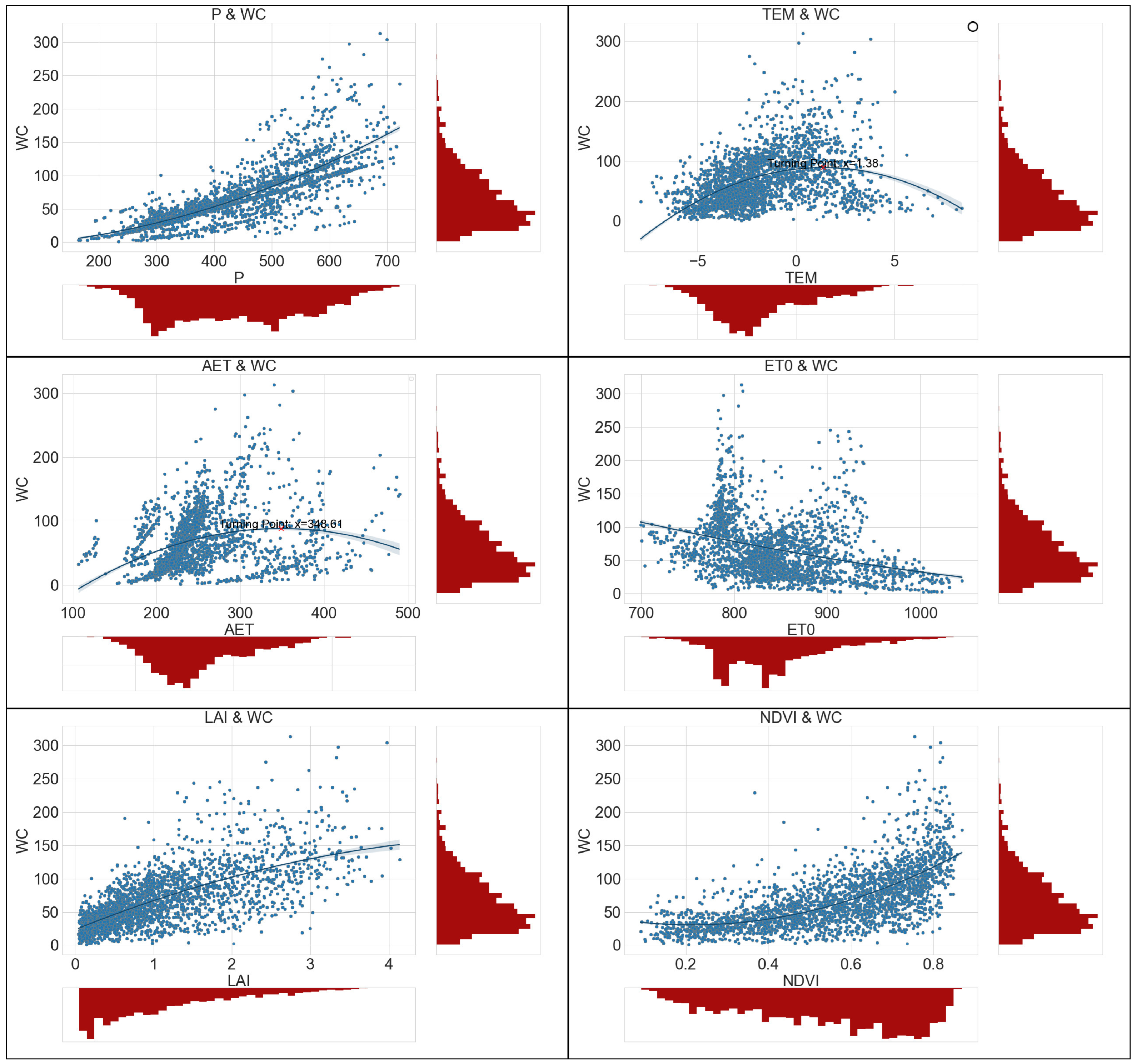
Appendix B. Establishment of the InVEST Model
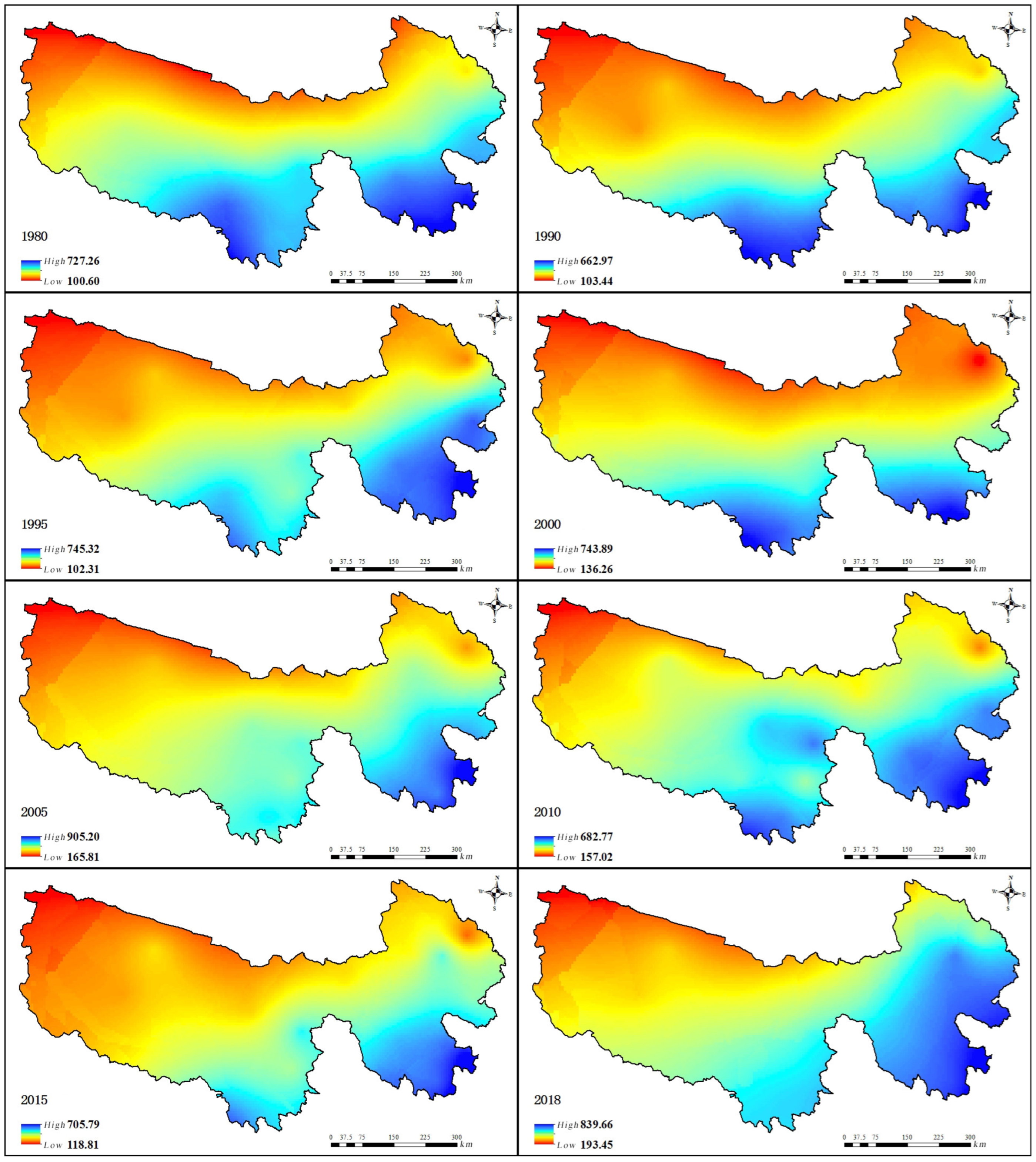






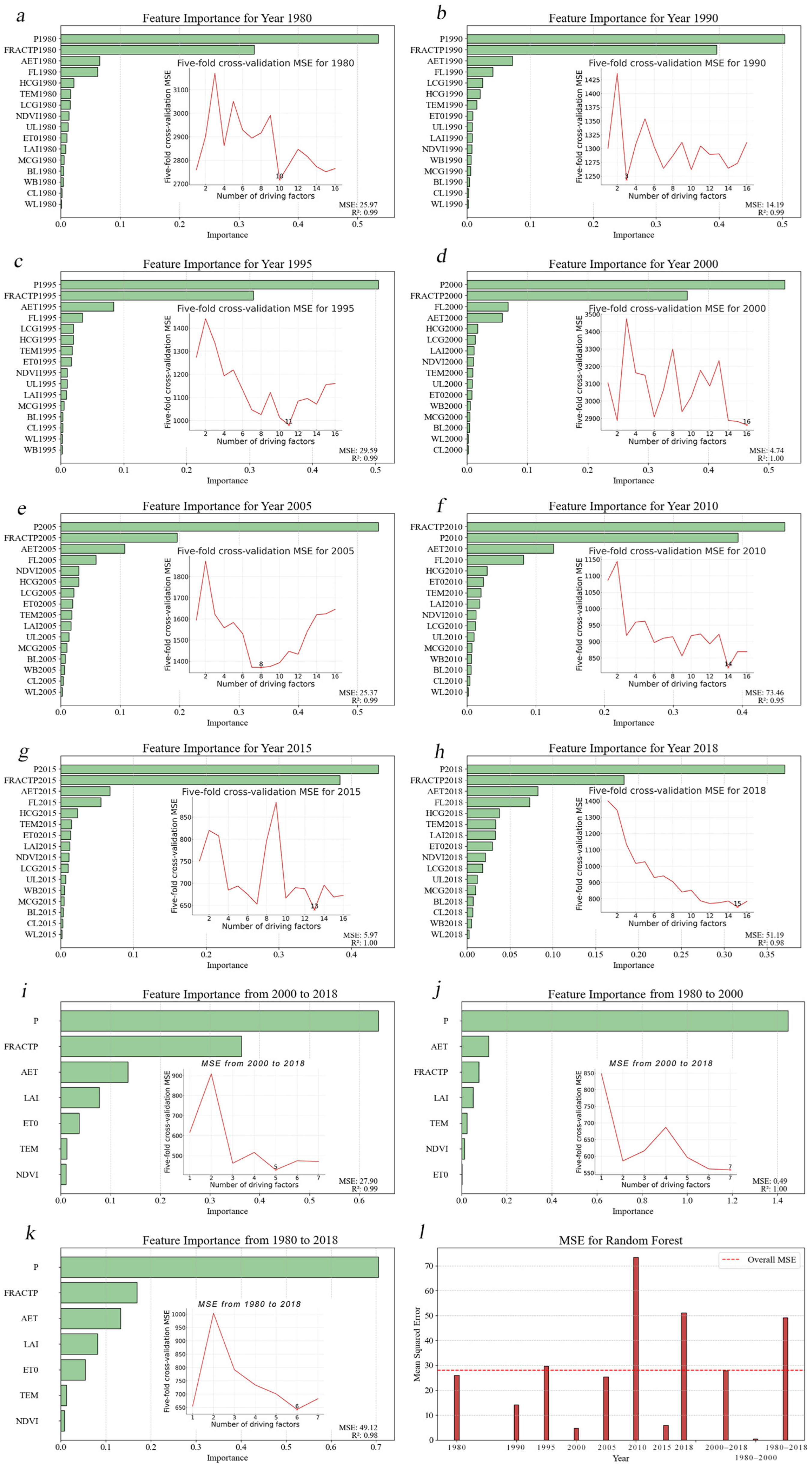

| Abbreviations and Symbols | Meanings | Units |
|---|---|---|
| AET | Actual Evapotranspiration | mm |
| AWC | Effective soil water content | mm |
| BL | Built-up Land | - |
| CDA | Cumulative distance adjustment | - |
| CL | Cropland | - |
| DEM | Digital Elevation Model | - |
| es | Actual water vapor pressure | kPa |
| ET0 | Reference Crop Evapotranspiration | mm |
| FL | Forest Land | - |
| FRACTP | Aridity Index | - |
| G | Soil heat flux | MJ·m−2·d−1 |
| HCG | High-Coverage Grassland | - |
| IncMSE | Incremental mean squared error | consistent with element units |
| Kc | Actual crop coefficient | - |
| Ks | Saturated hydraulic conductivity | cm/d |
| LAI | Leaf Area Index | - |
| LCG | Low-Coverage Grassland | - |
| Li | Cumulative distance from mean value | consistent with element units |
| LRB | Lancang River Basin | - |
| LUCC | Land use and cover change | km2 |
| MCG | Medium-Coverage Grassland | - |
| M-K | Mann–Kendall | - |
| ML | Machine Learning | - |
| NDVI | Normalized Difference Vegetation Index | - |
| OM | Organic matter content in soil | % |
| P | Annual Precipitation | mm |
| PAWC | Minimum values of plant available water content | mm |
| PET | Potential evapotranspiration | mm |
| r | Pearson correlation coefficient | - |
| Multiyear average of the element | consistent with element units | |
| RF | Random forest | - |
| Ri | Element value of the ith year | consistent with element units |
| Rn | Net surface radiation | MJ·m−2·d−1 |
| Sij | Region where the ith land use category has been converted into the jth land use category | - |
| Tmean | Average daily temperature at a height of 2 m | °C |
| TEM | Average Annual Temperature | °C |
| TI | Dimensionless topographic index | - |
| TRHR | Three-River Headstreams Region | - |
| u2 | Wind speed at a 2 m height | m/s |
| UL | Unused Land | - |
| Velocity | Flow rate coefficient | - |
| WB | Water Bodies | - |
| WC | Water conservation | mm |
| WL | Wetland | - |
| Yield | Water yield | mm |
| YRB | Yellow River Basin | - |
| YZRB | Yangtze River Basin | - |
| Z | Zhang empirical coefficient | - |
| α | Catchment area per unit contour length at any point of the flow through the slope | km2 |
| β | Slope angle | ° |
| γ | Wet and dry gauge constants | kPa/°C |
| Plant-available water coefficient | - | |
| △ | Slope of the saturation water vapor pressure curve | kPa/°C |
References
- Ali, D.A.; Deininger, K.; Monchuk, D. Using satellite imagery to assess impacts of soil and water conservation measures: Evidence from Ethiopia’s Tana-Beles watershed. Ecol. Econ. 2020, 169, 106512. [Google Scholar] [CrossRef]
- Bonell, M. Progress in the understanding of runoff generation dynamics in forests. J. Hydrol. 1993, 150, 217–275. [Google Scholar] [CrossRef]
- Costanza, R.; D’Arge, R.; De Groot, R.; Farber, S.; Grasso, M.; Hannon, B.; Limburg, K.; Naeem, S.; O’Neill, R.V.; Paruelo, J.; et al. The value of the world’s ecosystem services and natural capital. Ecol. Econ. 1998, 25, 3–15. [Google Scholar] [CrossRef]
- Baker, T.J.; Miller, S.N. Using the Soil and Water Assessment Tool (SWAT) to assess land use impact on water resources in an East African watershed. J. Hydrol. 2013, 486, 100–111. [Google Scholar] [CrossRef]
- Benra, F.; De Frutos, A.; Gaglio, M.; Álvarez-Garretón, C.; Felipe-Lucia, M.; Bonn, A. Mapping water ecosystem services: Evaluating InVEST model predictions in data scarce regions. Environ. Model. Softw. 2021, 138, 104982. [Google Scholar] [CrossRef]
- Chen, J.M.; Chen, X.; Ju, W.; Geng, X. Distributed hydrological model for mapping evapotranspiration using remote sensing inputs. J. Hydrol. 2005, 305, 15–39. [Google Scholar] [CrossRef]
- Goldstein, J.H.; Caldarone, G.; Duarte, T.K.; Ennaanay, D.; Hannahs, N.; Mendoza, G.; Polasky, S.; Wolny, S.; Daily, G.C. Integrating ecosystem-service tradeoffs into land-use decisions. Proc. Natl. Acad. Sci. USA 2012, 109, 7565–7570. [Google Scholar] [CrossRef]
- Hamel, P.; Chaplin-Kramer, R.; Sim, S.; Mueller, C. A new approach to modeling the sediment retention service (InVEST 3.0): Case study of the Cape Fear catchment, North Carolina, USA. Sci. Total Environ. 2015, 524–525, 166–177. [Google Scholar] [CrossRef] [PubMed]
- Redhead, J.; Stratford, C.; Sharps, K.; Jones, L.; Ziv, G.; Clarke, D.; Oliver, T.; Bullock, J. Empirical validation of the InVEST water yield ecosystem service model at a national scale. Sci. Total Environ. 2016, 569–570, 1418–1426. [Google Scholar] [CrossRef]
- Pessacg, N.; Flaherty, S.; Brandizi, L.; Solman, S.; Pascual, M. Getting water right: A case study in water yield modelling based on precipitation data. Sci. Total Environ. 2015, 537, 225–234. [Google Scholar] [CrossRef]
- Jia, G.; Hu, W.; Zhang, B.; Li, G.; Shen, S.; Gao, Z.; Li, Y. Assessing impacts of the Ecological Retreat project on water conservation in the Yellow River Basin. Sci. Total Environ. 2022, 828, 154483. [Google Scholar] [CrossRef] [PubMed]
- Wu, C.; Qiu, D.; Gao, P.; Mu, X.; Zhao, G. Application of the InVEST model for assessing water yield and its response to precipitation and land use in the Weihe River Basin, China. J. Arid Land 2022, 14, 426–440. [Google Scholar] [CrossRef]
- Yang, J.; Xie, B.; Zhang, D.; Tao, W. Climate and land use change impacts on water yield ecosystem service in the Yellow River Basin, China. Environ. Earth Sci. 2021, 80, 72. [Google Scholar] [CrossRef]
- Wang, J.; Wu, T.; Li, Q.; Wang, S. Quantifying the effect of environmental drivers on water conservation variation in the eastern Loess Plateau, China. Ecol. Indic. 2021, 125, 107493. [Google Scholar] [CrossRef]
- Wang, Y.; Ye, A.; Peng, D.; Miao, C.; Di, Z.; Gong, W. Spatiotemporal variations in water conservation function of the Tibetan Plateau under climate change based on InVEST model. J. Hydrol. Reg. Stud. 2022, 41, 101064. [Google Scholar] [CrossRef]
- Xue, J.; Li, Z.; Feng, Q.; Gui, J.; Zhang, B. Spatiotemporal variations of water conservation and its influencing factors in ecological barrier region, Qinghai-Tibet Plateau. J. Hydrol. Reg. Stud. 2022, 42, 101164. [Google Scholar] [CrossRef]
- Bi, Y.; Zheng, L.; Wang, Y.; Li, J.; Yang, H.; Zhang, B. Coupling relationship between urbanization and water-related ecosystem services in China’s Yangtze River economic Belt and its socio-ecological driving forces: A county-level perspective. Ecol. Indic. 2023, 146, 109871. [Google Scholar] [CrossRef]
- Li, M.; Liang, D.; Xia, J.; Song, J.; Cheng, D.; Wu, J.; Cao, Y.; Sun, H.; Li, Q. Evaluation of water conservation function of Danjiang River Basin in Qinling Mountains, China based on InVEST model. J. Environ. Manag. 2021, 286, 112212. [Google Scholar] [CrossRef]
- Chen, Q.; Xu, X.; Wu, M.; Wen, J.; Zou, J. Assessing the Water Conservation Function Based on the InVEST Model: Taking Poyang Lake Region as an Example. Land 2022, 11, 2228. [Google Scholar] [CrossRef]
- Hu, W.; Li, G.; Li, Z. Spatial and temporal evolution characteristics of the water conservation function and its driving factors in regional lake wetlands—Two types of homogeneous lakes as examples. Ecol. Indic. 2021, 130, 108069. [Google Scholar] [CrossRef]
- Wang, X.; Liu, L.; Zhang, S.; Gao, C. Dynamic simulation and comprehensive evaluation of the water resources carrying capacity in Guangzhou city, China. Ecol. Indic. 2022, 135, 108528. [Google Scholar] [CrossRef]
- Yin, L.; Dai, E.; Guan, M.; Zhang, B. A novel approach for the identification of conservation priority areas in mountainous regions based on balancing multiple ecosystem services—A case study in the Hengduan Mountain region. Glob. Ecol. Conserv. 2022, 38, e02195. [Google Scholar] [CrossRef]
- Cheng, L.; Chen, X.; De Vos, J.; Lai, X.; Witlox, F. Applying a random forest method approach to model travel mode choice behavior. Travel Behav. Soc. 2019, 14, 1–10. [Google Scholar] [CrossRef]
- Bagheri, M.; Farshforoush, N.; Bagheri, K.; Shemirani, A.I. Applications of artificial intelligence technologies in water environments: From basic techniques to novel tiny machine learning systems. Process. Saf. Environ. Prot. 2023, 180, 10–22. [Google Scholar] [CrossRef]
- Li, Z.; Wang, W.; Ji, X.; Wu, P.; Zhuo, L. Machine learning modeling of water footprint in crop production distinguishing water supply and irrigation method scenarios. J. Hydrol. 2023, 625, 130171. [Google Scholar] [CrossRef]
- Lu, Y.; Tuo, Y.; Xia, H.; Zhang, L.; Chen, M.; Li, J. Prediction model of the outflow temperature from stratified reservoir regulated by stratified water intake facility based on machine learning algorithm. Ecol. Indic. 2023, 154, 110560. [Google Scholar] [CrossRef]
- Li, S.; Yu, D.; Huang, T.; Hao, R. Identifying priority conservation areas based on comprehensive consideration of biodiversity and ecosystem services in the Three-River Headwaters Region, China. J. Clean. Prod. 2022, 359, 132082. [Google Scholar] [CrossRef]
- Ma, T.; Swallow, B.; Foggin, J.M.; Zhong, L.; Sang, W. Co-management for sustainable development and conservation in Sanjiangyuan National Park and the surrounding Tibetan nomadic pastoralist areas. Humanit. Soc. Sci. Commun. 2023, 10, 321. [Google Scholar] [CrossRef]
- Shao, Q.; Cao, W.; Fan, J.; Huang, L.; Xu, X. Effects of an ecological conservation and restoration project in the Three-River Source Region, China. J. Geogr. Sci. 2017, 27, 183–204. [Google Scholar] [CrossRef]
- Ahmed, N.; Wang, G.; Booij, M.J.; Oluwafemi, A.; Hashmi, M.Z.-U.; Ali, S.; Munir, S. Climatic Variability and Periodicity for Upstream Sub-Basins of the Yangtze River, China. Water 2020, 12, 842. [Google Scholar] [CrossRef]
- Pan, Y.; Yin, Y. Spatial and Temporal Evolution Characteristics of Water Conservation in the Three-Rivers Headwater Region and the Driving Factors over the Past 30 Years. Atmosphere 2023, 14, 1453. [Google Scholar] [CrossRef]
- Yuan, X.; Wang, W.; Cui, J.; Meng, F.; Kurban, A.; De Maeyer, P. Vegetation changes and land surface feedbacks drive shifts in local temperatures over Central Asia. Sci. Rep. 2017, 7, 3287. [Google Scholar] [CrossRef]
- Cominola, A.; Giuliani, M.; Castelletti, A.; Fraternali, P.; Gonzalez, S.L.H.; Herrero, J.C.G.; Novak, J.; Rizzoli, A.E. Long-term water conservation is fostered by smart meter-based feedback and digital user engagement. NPJ Clean Water 2021, 4, 29. [Google Scholar] [CrossRef]
- Liu, D.; Cao, C.; Dubovyk, O.; Tian, R.; Chen, W.; Zhuang, Q.; Zhao, Y.; Menz, G. Using fuzzy analytic hierarchy process for spatio-temporal analysis of eco-environmental vulnerability change during 1990–2010 in Sanjiangyuan region, China. Ecol. Indic. 2017, 73, 612–625. [Google Scholar] [CrossRef]
- Li, Z.; Li, Z.; Qi, F.; Wang, X.; Mu, Y.; Xin, H.; Song, L.; Juan, G.; Zhang, B.; Gao, W.; et al. Hydrological effects of multiphase water transformation in Three-River Headwaters Region, China. J. Hydrol. 2021, 601, 126662. [Google Scholar] [CrossRef]
- Li, Y.; Li, B.; Yuan, Y.; Lei, Q.; Jiang, Y.; Liu, Y.; Li, R.; Liu, W.; Zhai, D.; Xu, J. Trends in total nitrogen concentrations in the Three Rivers Headwater Region. Sci. Total. Environ. 2022, 852, 158462. [Google Scholar] [CrossRef] [PubMed]
- Lv, L.-S.; Jin, D.-H.; Ma, W.-J.; Liu, T.; Xu, Y.-Q.; Zhang, X.-E.; Zhou, C.-L. The Impact of Non-optimum Ambient Temperature on Years of Life Lost: A Multi-county Observational Study in Hunan, China. Int. J. Environ. Res. Public Health 2020, 17, 2699. [Google Scholar] [CrossRef] [PubMed]
- Shangguan, W.; Dai, Y. A China Soil Characteristics Dataset (2010); National Tibetan Plateau/Third Pole Environment Data Center: Lhasa, China, 2023. [Google Scholar] [CrossRef]
- Fan, X.; Wang, L.; Li, X.; Zhou, J.; Chen, D.; Yang, H. Increased discharge across the Yellow River Basin in the 21st century was dominated by precipitation in the headwater region. J. Hydrol. Reg. Stud. 2022, 44, 101230. [Google Scholar] [CrossRef]
- Liu, Y.; Liu, R.; Chen, J.M. Retrospective retrieval of long-term consistent global leaf area index (1981–2011) from combined AVHRR and MODIS data. J. Geophys. Res. Biogeosci. 2012, 117, G04003. [Google Scholar] [CrossRef]
- Piao, S.; Fang, J.; Zhou, L.; Ciais, P.; Zhu, B. Variations in Satellite-Derived Phenology in China’s Temperate Vegetation. Glob. Change Biol. 2006, 12, 672–685. [Google Scholar] [CrossRef]
- Nascimento, C.M.; Mendes, W.d.S.; Silvero, N.E.Q.; Poppiel, R.R.; Sayão, V.M.; Dotto, A.C.; dos Santos, N.V.; Amorim, M.T.A.; Demattê, J.A. Soil degradation index developed by multitemporal remote sensing images, climate variables, terrain and soil atributes. J. Environ. Manag. 2021, 277, 111316. [Google Scholar] [CrossRef] [PubMed]
- Negash, T.W.; Bayisa, G.D.; Tefera, A.T.; Bizuneh, K.T.; Dinku, A.G.; Awulachew, T.W.; Bikela, G.A. Evapotranspiration and crop coefficient of sorghum (Sorghum bicolor L.) at melkassa farmland, semi-arid area of ethiopia. Air Soil Water Res. 2023, 16, 11786221231184206. [Google Scholar] [CrossRef]
- Minga-León, S.; Gómez-Albores, M.A.; Bâ, K.M.; Balcázar, L.; Manzano-Solís, L.R.; Cuervo-Robayo, A.P.; Mastachi-Loza, C.A. Estimation of water yield in the hydrographic basins of southern Ecuador. Hydrol. Earth Syst. Sci. Discuss. 2018, 1–18. [Google Scholar] [CrossRef]
- Liu, Y.; Li, Z.; Chen, Y.; Li, Y.; Li, H.; Xia, Q.; Kayumba, P.M. Evaluation of consistency among three NDVI products applied to High Mountain Asia in 2000–2015. Remote Sens. Environ. 2022, 269, 112821. [Google Scholar] [CrossRef]
- Xu, H.-J.; Zhao, C.-Y.; Wang, X.-P.; Chen, S.-Y.; Shan, S.-Y.; Chen, T.; Qi, X.-L. Spatial differentiation of determinants for water conservation dynamics in a dryland mountain. J. Clean. Prod. 2022, 362, 132574. [Google Scholar] [CrossRef]
- Jolliffe, I.T.; Philipp, A. Some recent developments in cluster analysis. Phys. Chem. Earth Parts A/B/C 2010, 35, 309–315. [Google Scholar] [CrossRef]
- Govender, P.; Sivakumar, V. Application of k-means and hierarchical clustering techniques for analysis of air pollution: A review (1980–2019). Atmos. Pollut. Res. 2020, 11, 40–56. [Google Scholar] [CrossRef]
- Sipper, M.; Moore, J.H. Conservation machine learning: A case study of random forests. Sci. Rep. 2021, 11, 3629. [Google Scholar] [CrossRef]
- Hu, J.; Yan, C.; Liu, X.; Li, Z.; Ren, C.; Zhang, J.; Peng, D.; Yang, Y. An integrated classification model for incremental learning. Multimedia Tools Appl. 2021, 80, 17275–17290. [Google Scholar] [CrossRef]
- Han, S.; Williamson, B.D.; Fong, Y. Improving random forest predictions in small datasets from two-phase sampling designs. BMC Med. Inform. Decis. Mak. 2021, 21, 322. [Google Scholar] [CrossRef]
- Li, Q.; Shi, X.; Zhao, Z.; Wu, Q. Ecological restoration in the source region of Lancang River: Based on the relationship of plant diversity, stability and environmental factors. Ecol. Eng. 2022, 180, 106649. [Google Scholar] [CrossRef]
- Liu, S.; Cui, B.; Dong, S.; Yang, Z.; Yang, M.; Holt, K. Evaluating the influence of road networks on landscape and regional ecological risk—A case study in Lancang River Valley of Southwest China. Ecol. Eng. 2008, 34, 91–99. [Google Scholar] [CrossRef]
- van Dijke, A.J.H.; Herold, M.; Mallick, K.; Benedict, I.; Machwitz, M.; Schlerf, M.; Pranindita, A.; Theeuwen, J.J.E.; Bastin, J.-F.; Teuling, A.J. Shifts in regional water availability due to global tree restoration. Nat. Geosci. 2022, 15, 363–368. [Google Scholar] [CrossRef]
- Sun, N.; Yan, H.; Wigmosta, M.S.; Lundquist, J.; Dickerson-Lange, S.; Zhou, T. Forest Canopy Density Effects on Snowpack across the Climate Gradients of the Western United States Mountain Ranges. Water Resour. Res. 2022, 58, e2020WR029194. [Google Scholar] [CrossRef]
- Wang, Y.; Wang, H.; Zhang, J.; Liu, G.; Fang, Z.; Wang, D. Exploring interactions in water-related ecosystem services nexus in Loess Plateau. J. Environ. Manag. 2023, 336, 117550. [Google Scholar] [CrossRef]
- Zhang, Z.; Zhang, L.; Xu, H.; Creed, I.F.; Blanco, J.A.; Wei, X.; Sun, G.; Asbjornsen, H.; Bishop, K. Forest water-use efficiency: Effects of climate change and management on the coupling of carbon and water processes. For. Ecol. Manag. 2023, 534, 120853. [Google Scholar] [CrossRef]
- Zhao, H.; Wang, X.; Wu, C. Ecosystem water use efficiency was enhanced by the implementation of forest conservation and restoration programs in China. J. Hydrol. 2023, 617, 128979. [Google Scholar] [CrossRef]
- Admasu, S.; Yeshitela, K.; Argaw, M. Impacts of Land Use Land Cover Changes and Climate Variability on Water Yield in the Dire and Legedadi Watersheds central Ethiopia. Water Conserv. Sci. Eng. 2023, 8, 14. [Google Scholar] [CrossRef]
- Gao, M.; Chen, X.; Li, G.; Wang, J.; Dong, J. Impacts of elevational variability of climate and frozen ground on streamflow in a glacierized catchment in Tibetan Plateau. J. Hydrol. 2023, 619, 129312. [Google Scholar] [CrossRef]
- Kuo, C.-C.; Liu, Y.-C.; Su, Y.; Liu, H.-Y.; Lin, C.-T. Responses of alpine summit vegetation under climate change in the transition zone between subtropical and tropical humid environment. Sci. Rep. 2022, 12, 13352. [Google Scholar] [CrossRef] [PubMed]
- Luo, Y.; Wang, X.; Piao, S.; Sun, L.; Ciais, P.; Zhang, Y.; Ma, C.; Gan, R.; He, C. Contrasting streamflow regimes induced by melting glaciers across the Tien Shan—Pamir—North Karakoram. Sci. Rep. 2018, 8, 16470. [Google Scholar] [CrossRef] [PubMed]
- Zhao, M.; Liu, Y.; Konings, A.G. Evapotranspiration frequently increases during droughts. Nat. Clim. Change 2022, 12, 1024–1030. [Google Scholar] [CrossRef]
- Li, X.; Zhang, Y.; Ji, X.; Strauss, P.; Zhang, Z. Effects of shrub-grass cover on the hillslope overland flow and soil erosion under simulated rainfall. Environ. Res. 2022, 214, 113774. [Google Scholar] [CrossRef] [PubMed]
- Zhu, G.; Yong, L.; Zhao, X.; Liu, Y.; Zhang, Z.; Xu, Y.; Sun, Z.; Sang, L.; Wang, L. Evaporation, infiltration and storage of soil water in different vegetation zones in the Qilian Mountains: A stable isotope perspective. Hydrol. Earth Syst. Sci. 2022, 26, 3771–3784. [Google Scholar] [CrossRef]
- Tianjiao, F.; Tianxing, W.; Keesstra, S.D.; Jianjun, Z.; Huaxing, B.; Ruoshui, W.; Ping, W. Long-term effects of vegetation restoration on hydrological regulation functions and the implications to afforestation on the Loess Plateau. Agric. For. Meteorol. 2023, 330, 109313. [Google Scholar] [CrossRef]
- Chang, Y.; Ding, Y.; Zhang, S.; Qin, J.; Zhao, Q. Dynamics and environmental controls of evapotranspiration for typical alpine meadow in the northeastern Tibetan Plateau. J. Hydrol. 2022, 612, 128282. [Google Scholar] [CrossRef]
- Gao, Y.; Chen, F.; Miguez-Macho, G.; Li, X. Understanding precipitation recycling over the Tibetan Plateau using tracer analysis with WRF. Clim. Dyn. 2020, 55, 2921–2937. [Google Scholar] [CrossRef]
- Ma, Y.-J.; Li, X.-Y.; Liu, L.; Yang, X.-F.; Wu, X.-C.; Wang, P.; Lin, H.; Zhang, G.-H.; Miao, C.-Y. Evapotranspiration and its dominant controls along an elevation gradient in the Qinghai Lake watershed, northeast Qinghai-Tibet Plateau. J. Hydrol. 2019, 575, 257–268. [Google Scholar] [CrossRef]
- Hirsch, R.M.; Slack, J.R. A Nonparametric Trend Test for Seasonal Data with Serial Dependence. Water Resour. Res. 1984, 20, 727–732. [Google Scholar] [CrossRef]
- Moarrab, Y.; Salehi, E.; Amiri, M.J.; Hovidi, H. Spatial–temporal assessment and modeling of ecological security based on land-use/cover changes (case study: Lavasanat watershed). Int. J. Environ. Sci. Technol. 2022, 19, 3991–4006. [Google Scholar] [CrossRef]
- Wang, Y.; Zhang, S.; Chang, X. Evapotranspiration Estimation Based on Remote Sensing and the SEBAL Model in the Bosten Lake Basin of China. Sustainability 2020, 12, 7293. [Google Scholar] [CrossRef]
- Zhang, B.; Li, W.; Xie, G.; Xiao, Y. Water conservation of forest ecosystem in Beijing and its value. Ecol. Econ. 2010, 69, 1416–1426. [Google Scholar] [CrossRef]
- Chen, L.; Zhou, B.; Man, W.; Liu, M. Landsat-Based Monitoring of the Heat Effects of Urbanization Directions and Types in Hangzhou City from 2000 to 2020. Remote Sens. 2021, 13, 4268. [Google Scholar] [CrossRef]
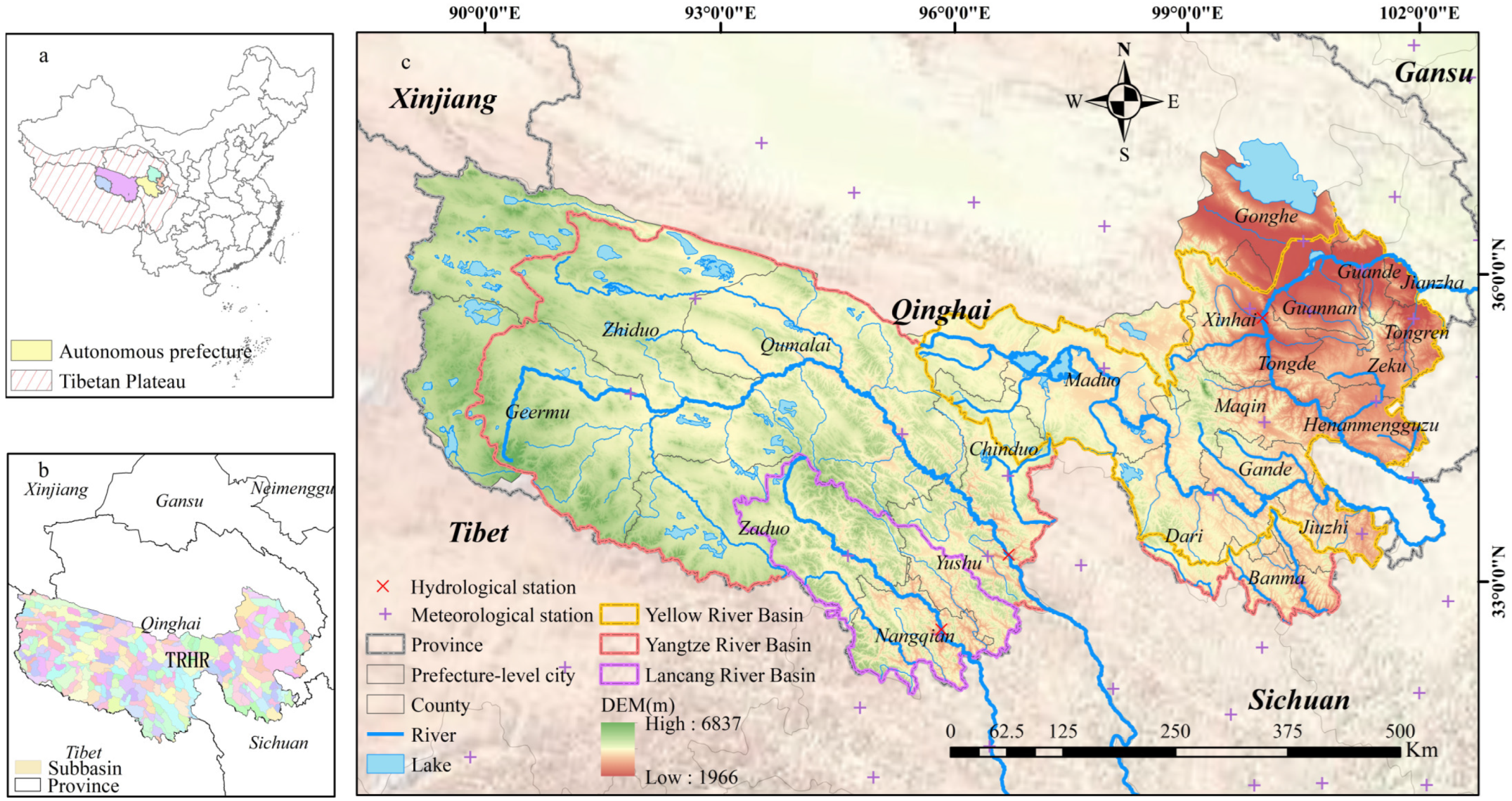


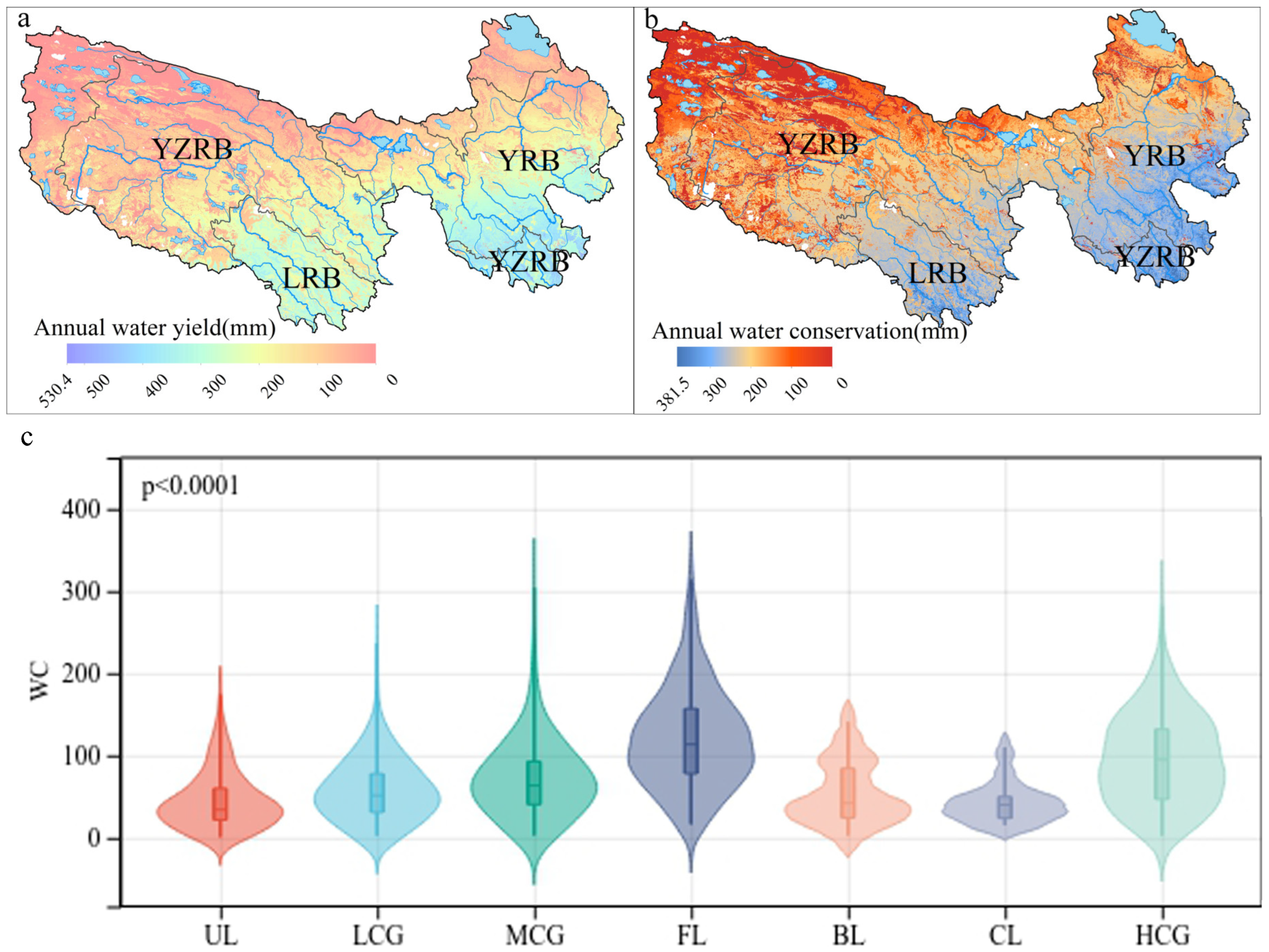
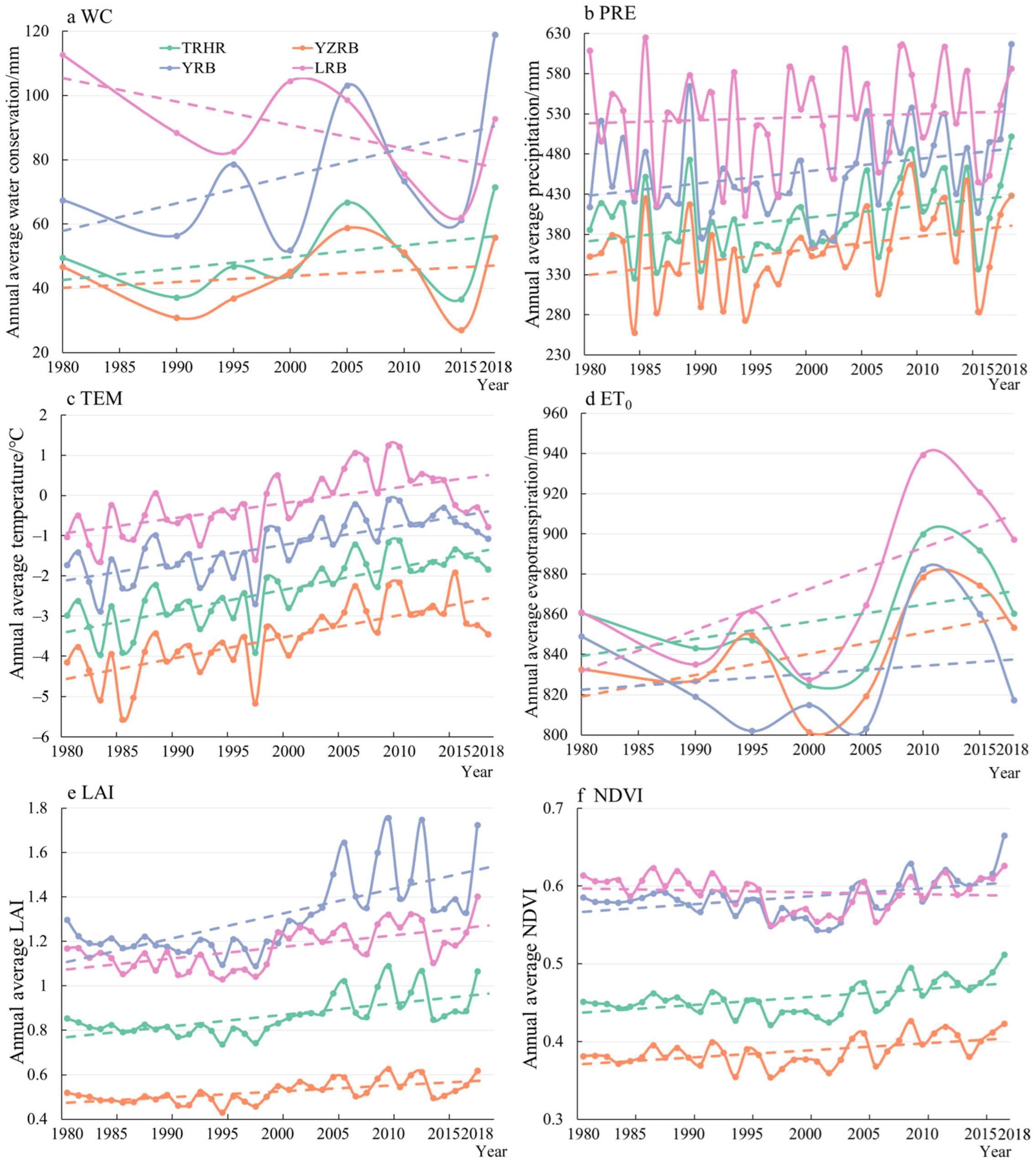
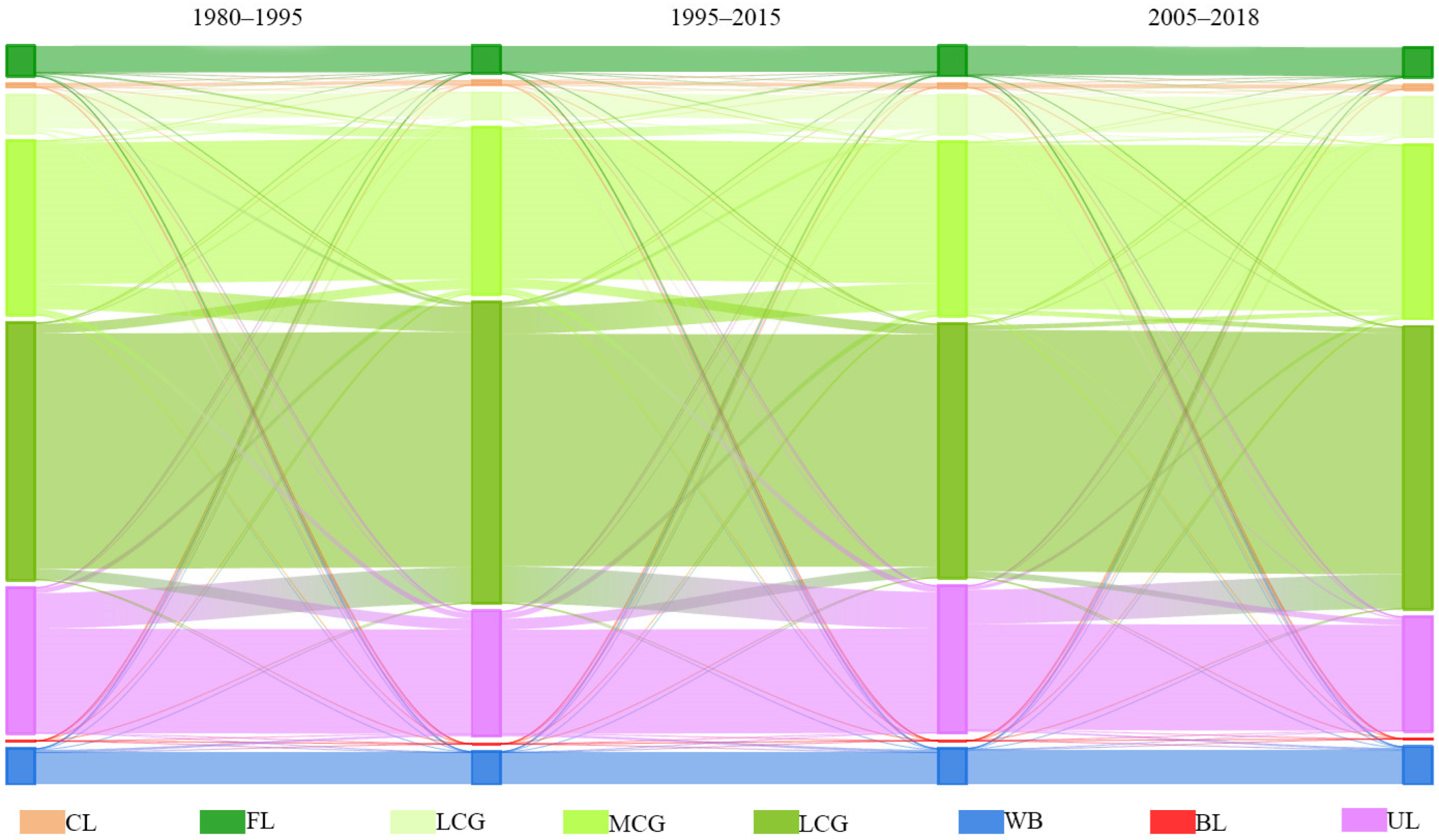
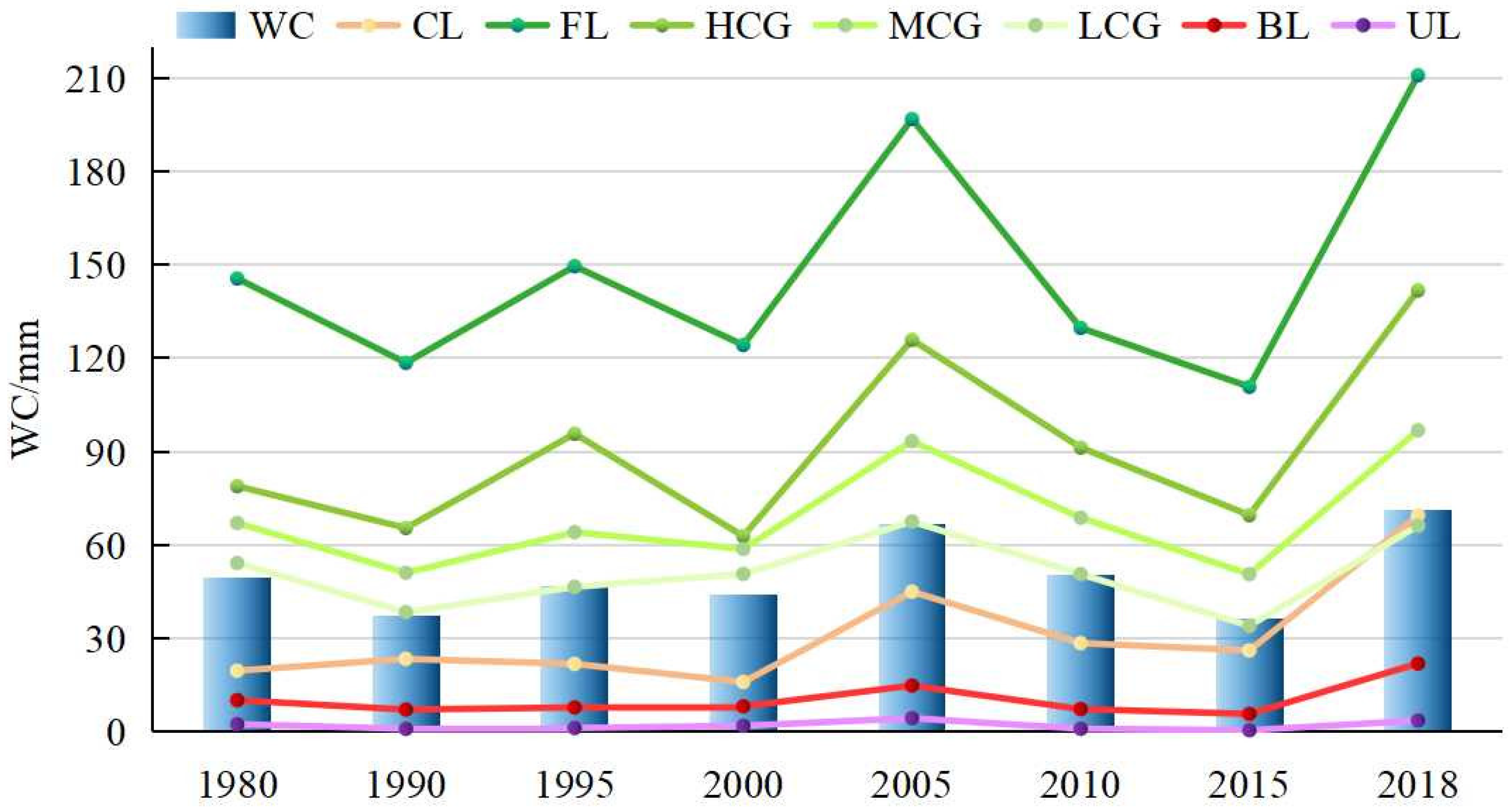

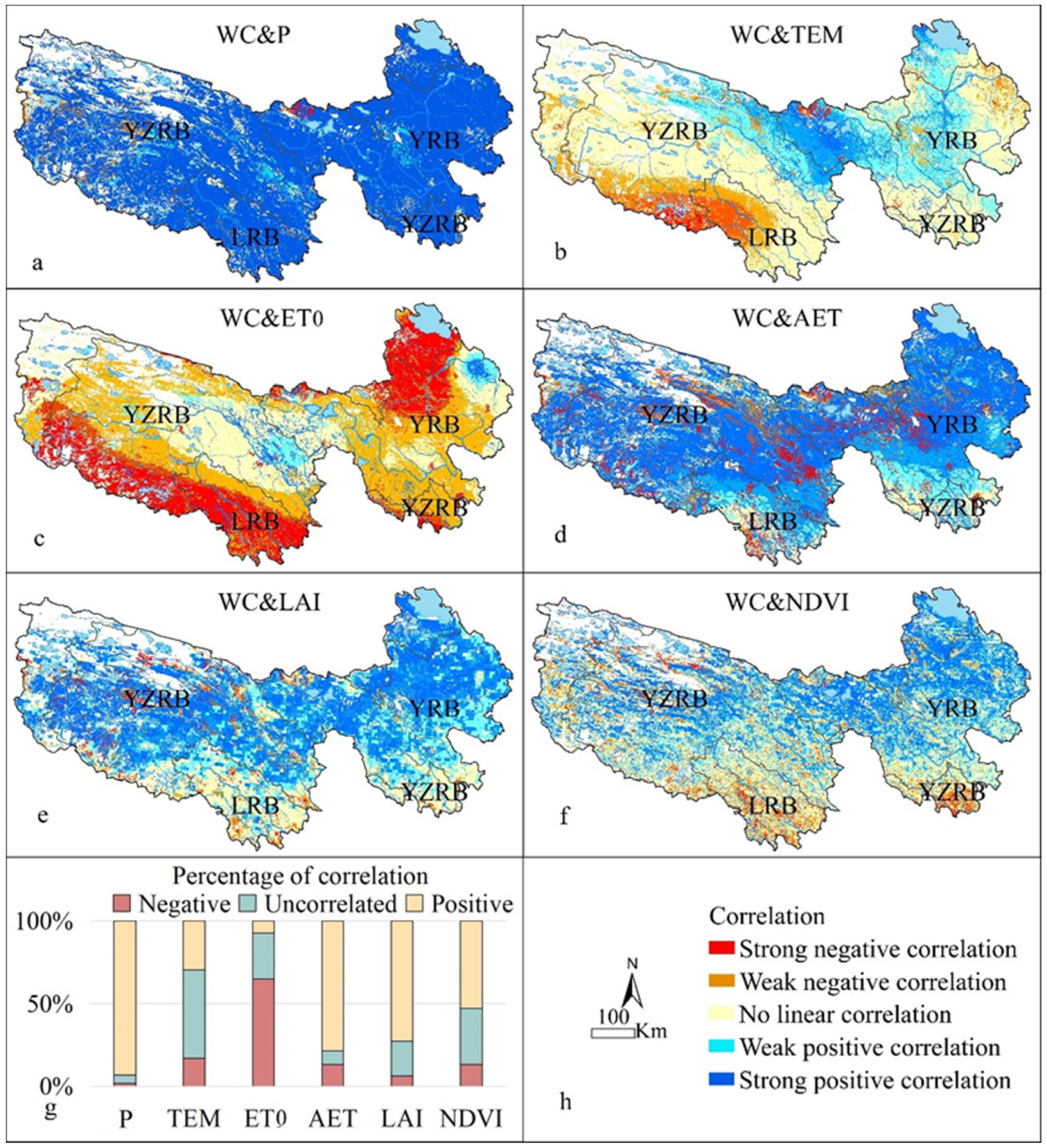


| Data Type | Description | Source | Format |
|---|---|---|---|
| Climate data | Meteorological parameters such as average temperature (°C), maximum temperature (°C), minimum temperature (°C), average relative humidity (%), average wind speed (m/s), and precipitation from 86 meteorological stations from 1980 to 2020. | China Meteorological Data Service Center (http://data.cma.cn/, accessed on 2 February 2023) | Raster |
| Annual runoff | Annual runoff data and cross-sectional area of three hydrological stations, including Zhimen Da, Xiangda, and Tangnaihai. | Hydrological stations | Point |
| DEM | Digital elevation model with a spatial resolution of 30 m, derived by splicing and organizing the latest SRTM V4.1 data. | China Geographic Data Cloud Platform (https://www.gscloud.cn/home, accessed on 2 February 2023) | Raster |
| Land use | Eight periods of land use/cover data from 1980 to 2018, with projection coordinate system of Krasovsky_1940_Albers and spatial resolution of 30 m. | Chinese Academy of Sciences Resource and Environment Science Data Center (https://www.resdc.cn/, accessed on 5 February 2023) | Raster |
| Soil data | Soil texture parameters including clay, sand, and silt content as well as organic matter content (%) from three layers of soil with depth ranges of 4.5–9.1 cm, 16.6–28.9 cm, and 49.3–82.9 cm. The arithmetic mean of the three parameters is used as the soil texture parameter value. | National Tibetan Plateau Data Center (https://data.tpdc.ac.cn/home, accessed on 7 February 2023) | Raster |
| LAI | Leaf Area Index data from 1981 to 2018 with a spatial resolution of 8 km and projection coordinate system of Krasovsky_1940_Albers. | Chinese Academy of Sciences Resource and Environment Science Data Center (https://www.resdc.cn/, accessed on 10 February 2023) | Raster |
| NDVI | Annual NDVI raster data from 1982 to 2018. | National Tibetan Plateau Data Center (https://data.tpdc.ac.cn/home, accessed on 12 February 2023), Chinese Academy of Sciences Resource and Environment Science Data Center (https://www.resdc.cn/, accessed on 15 February 2023) | Raster |
| Type | Indicator | Abbreviation | Unit |
|---|---|---|---|
| Climate | Annual Precipitation | P | mm |
| Average Annual Temperature | TEM | °C | |
| Reference Crop Evapotranspiration | ET0 | mm | |
| Actual Evapotranspiration | AET | mm | |
| Vegetation | Leaf Area Index | LAI | - |
| Normalized Vegetation Index | NDVI | - | |
| Land Use Type | Land Use and Cover Change | LUCC | km2 |
| Land Use | LUCODE | Kc | Root Depth/mm | Vegetation Cover |
|---|---|---|---|---|
| Cropland (CL) | 1 | 0.67 | 400 | 1 |
| Forest Land (FL) | 2 | 1 | 800 | 1 |
| High-Coverage Grassland (HCG) | 3 | 0.65 | 500 | 1 |
| Medium-Coverage Grassland (MCG) | 4 | 0.60 | 400 | 1 |
| Low-Coverage Grassland (LCG) | 5 | 0.56 | 300 | 1 |
| Water Bodies (WB) and Wetland (WL) | 6 and 9 | 0.9 | 1 | 0 |
| Built-up Land (BL) | 7 | 0.239 | 1 | 0 |
| Unused Land (UL) | 8 | 0.4 | 200 | 0 |
| Land Use Type | 1980 | 1990 | 1995 | 2000 | 2005 | 2010 | 2015 | 2018 |
|---|---|---|---|---|---|---|---|---|
| CL | 0.042 | 0.052 | 0.052 | 0.037 | 0.104 | 0.073 | 0.067 | 0.177 |
| FL | 2.391 | 1.947 | 2.232 | 2.044 | 3.234 | 2.118 | 1.809 | 3.443 |
| HCG | 1.623 | 1.374 | 1.396 | 1.319 | 2.647 | 1.981 | 1.510 | 3.074 |
| MCG | 6.339 | 4.827 | 5.816 | 5.571 | 8.815 | 6.500 | 4.788 | 9.139 |
| LCG | 7.544 | 5.321 | 7.592 | 6.997 | 9.289 | 7.741 | 5.209 | 10.119 |
| BL | 0.002 | 0.001 | 0.001 | 0.001 | 0.002 | 0.001 | 0.001 | 0.006 |
| UL | 0.196 | 0.079 | 0.084 | 0.156 | 0.351 | 0.065 | 0.036 | 0.227 |
| Land Use Type | 2018 (km2) | Outgoing Area | ||||||||
|---|---|---|---|---|---|---|---|---|---|---|
| CL | FL | HCG | MCG | LCG | WB | BL | UL | |||
| 1980 (km2) | CL | 1859.89 | 1.93 | 26.74 | 38.00 | 79.42 | 84.62 | 17.54 | 8.29 | 256.53 |
| FL | 8.99 | 15,517.96 | 213.32 | 386.40 | 260.10 | 16.54 | 2.38 | 10.33 | 898.07 | |
| HCG | 248.85 | 132.29 | 18,857.80 | 397.03 | 416.10 | 110.85 | 9.55 | 366.74 | 1681.42 | |
| MCG | 276.10 | 391.04 | 1619.80 | 87,847.45 | 2905.52 | 197.22 | 38.67 | 1136.85 | 6565.20 | |
| LCG | 108.44 | 244.32 | 687.21 | 3563.09 | 130,061.69 | 498.20 | 44.63 | 3765.51 | 8911.40 | |
| WB | 19.40 | 4.96 | 19.65 | 101.12 | 529.48 | 18,151.49 | 2.52 | 377.30 | 1054.44 | |
| BL | 6.14 | 0.30 | 3.12 | 3.41 | 3.21 | 1.56 | 131.91 | 0.29 | 18.02 | |
| UL | 15.00 | 33.61 | 248.59 | 1996.25 | 18,437.08 | 1222.20 | 9.43 | 56,297.68 | 21,962.17 | |
| Incoming Area | 682.93 | 808.44 | 2818.42 | 6485.31 | 22,630.91 | 2131.21 | 124.71 | 5665.31 | 41,347.25 | |
Disclaimer/Publisher’s Note: The statements, opinions and data contained in all publications are solely those of the individual author(s) and contributor(s) and not of MDPI and/or the editor(s). MDPI and/or the editor(s) disclaim responsibility for any injury to people or property resulting from any ideas, methods, instructions or products referred to in the content. |
© 2024 by the authors. Licensee MDPI, Basel, Switzerland. This article is an open access article distributed under the terms and conditions of the Creative Commons Attribution (CC BY) license (https://creativecommons.org/licenses/by/4.0/).
Share and Cite
Xie, X.; Peng, M.; Zhang, L.; Chen, M.; Li, J.; Tuo, Y. Assessing the Impacts of Climate and Land Use Change on Water Conservation in the Three-River Headstreams Region of China Based on the Integration of the InVEST Model and Machine Learning. Land 2024, 13, 352. https://doi.org/10.3390/land13030352
Xie X, Peng M, Zhang L, Chen M, Li J, Tuo Y. Assessing the Impacts of Climate and Land Use Change on Water Conservation in the Three-River Headstreams Region of China Based on the Integration of the InVEST Model and Machine Learning. Land. 2024; 13(3):352. https://doi.org/10.3390/land13030352
Chicago/Turabian StyleXie, Xinyue, Min Peng, Linglei Zhang, Min Chen, Jia Li, and Youcai Tuo. 2024. "Assessing the Impacts of Climate and Land Use Change on Water Conservation in the Three-River Headstreams Region of China Based on the Integration of the InVEST Model and Machine Learning" Land 13, no. 3: 352. https://doi.org/10.3390/land13030352




